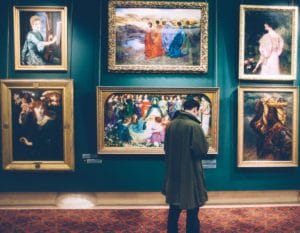
How Blockchain Can Change the High-End Art World
In 2016, global art market sales were estimated $45 billion. The majority of those sales came from the high-end art world where artwork can sell for millions of dollars. With such high stakes, high-end art has its fair share of con men and bad actors. Forgeries and fakes aren’t uncommon, and sometimes they pass muster as the genuine article. Additionally, financing art purchases and paying artists can be an opaque and expensive process. The blockchain revolution could change all that for the high-end art world.
Provenance & Forgery
One major area where blockchain could play an important role in the high-end art world is provenance. Provenance refers to the ownership history of a work of art. It’s the trail of ownership that leads all the way back to the artist who originally created the piece.
Currently, provenance is mostly managed by hand. It’s an owner’s responsibility to maintain a record of who has owned the piece before them. Certain high-value pieces have their provenance on file with a major gallery, museum, or auction house. However, there’s no central system for verifying and securing provenance.
Blockchain art provenance could create that single source of truth for an artwork’s history. Putting records on the blockchain makes them immutable and decentralized. A forger could not create false records on the blockchain under such a system.
Similarly, forgery gets more difficult when information about other pieces a painter has produced is freely available. For instance, the blockchain could hold information about the chemical qualities of the paint used or the type of canvas an artist used. Detecting a forgery becomes easier the more information you have to compare it to.
Digital Scarcity & High-End Art Investment
Blockchain is changing digital art with the ability to control reproduction and versioning. A big challenge in digital art is anyone can copy and distribute a digital file once they have access to it. With blockchain, you can create versions of digital art that are certified as originals. This creates a high-end market for digital art where none existed before because now digital art can be scarce.
On the other hand, certifying artwork means ownership of a piece of art is divisible. You could purchase a piece of artwork with a friend and each own 50% of the piece. This extends to selling shares of a piece of art, too. You could theoretically own a small share of the Mona Lisa if the Louvre museum decided to auction off shares.
This is a non-trivial development, because it means art museums can finance the purchase of new artwork by auctioning off shares of their existing collection. The benefit of this approach is huge since art museums currently pay high-interest rates for loans to purchase artwork. If blockchain allows for high-end art investment, then it could be a huge boon to museums everywhere.
Transparent Pricing & Payment Structure
Another benefit of using blockchain for high-end art management is smart contracts make pricing and terms transparent. Currently, the high-end art market is opaque by design. It’s meant for insiders, not the public. As a result, it can be confusing how much a gallery, auction house, or broker receives in commission on the sale of a piece of art. Especially for new art, the artist may not be getting a fair share of the proceeds.
Purchasing art with smart contracts could solve these transparency issues and help artists get paid. It could also mean that a community of art lovers could pool their resources to purchase a piece of art through a smart contract, democratizing access to the art market.
Will Galleries Use Blockchain?
This is the big question. Online art sales platforms have indicated that they’re interested in blockchain. Christie’s and Sotheby’s online art sales intend to offer blockchain technology solutions within the next five years. However, most physical galleries and exhibitors say they have no intention of using blockchain.
That may sound disheartening, but consider that a blockchain art market would greatly cut into the profits galleries and exhibitors could make because the artwork is now available on a decentralized platform. It makes sense that galleries would be interested in maintaining the status quo. That said, the blockchain art market is still mostly limited to digital art, and hasn’t yet reached the world of high-end art. That world may be so insular that it never will.
The best hope for blockchain in the high-end art market is if museums begin using it to verify and even sell shares in their high-end pieces. Over time, if enough museums adopt a blockchain art management platform, we could see blockchain gradually become a standard for the high-end art world.
The post How Blockchain Can Change the High-End Art World appeared first on CoinCentral.

Coincentral.com is author of this content, TheBitcoinNews.com is is not responsible for the content of external sites.
Our Social Networks: Facebook Instagram Pinterest Reddit Telegram Twitter Youtube










